Vukovar Bids Wartime Hospital Director Vesna Bosanac Farewell
ZAGREB, 24 March 2022 - Numerous Vukovar residents bid farewell to the wartime hospital director Dr Vesna Bosanac at the Homeland War Memorial Cemetery in Vukovar on Thursday.
Addressing those present at the burial ceremony, Dr Bosanac's long time deputy Siniša Maslovara bid her farewell.
"Most of us will remember her for caring for us all. She supported us and was there whenever we needed her, particularly when a serious misfortune or illness afflicted us. She loved her employees and fought for them to the limits of durability, even when everyone would leave them and when, sometimes, they would lose faith in themselves," Maslovara said.
He said that Bosanac seemed indestructible because she survived numerous misfortunes.
In the most difficult times for the hospital during the Homeland War, Dr Bosanac showed unimaginable courage, audacity and organisational skills, he underscored.
In addition to numerous Vukovar residents, also present at the funeral were the prime minister's envoy, Defence Minister Tomo Medved, Defence Minister Mario Banožić, Health Minister Vili Beroš, Vukovar-Srijem County Prefect Damir Dekanić and Vukovar Mayor Ivan Penava, who proclaimed today a day of mourning.
Vukovar Hospital staff paid their final respects to Dr Bosanac prior to her being taken to the cemetery. A commemorative ceremony will be held later this afternoon.
Vesna Bosanac died on Monday after a long and serious illness. She was 73.
Politics: For more, check out our politics section.
Lanterns Floated Down the Danube in Memory of Fallen and Missing Defenders, Civilians
ZAGREB, 18 Nov 2021 - Several hundred lit red and white lanterns were floated down the river Danube on Thursday evening in memory of Croatian defenders and civilians killed or gone missing in the defense of Vukovar from the Great Serbia aggression in 1991.
Red lanterns were lit in memory of the missing persons and white lanterns for the fallen defenders and civilians.
According to data collected by the Franciscan monastery in Vukovar, 2,717 persons were killed or went missing in Vukovar in the military aggression of the former Yugoslav People's Army (JNA) and Serb paramilitary groups.
Another 386 persons are on the list of persons detained or gone missing in the Homeland War, having disappeared without a trace in wartime Vukovar.
On the occasion of Vukovar Remembrance Day, tens of thousands of persons from Croatia and Bosnia, and Herzegovina passed through the city in the Remembrance Procession on Thursday on the 30th anniversary of the collapse of the city's defense, police estimates.
For the latest news about Croatia, click here.
Respects Paid to Vukovar and Škabrnja Victims at NATO Headquarters in Brussels
ZAGREB, 18 Nov 2021- Respects were paid to Vukovar and Škabrnja victims at NATO headquarters in Brussels, and that gesture sends a strong message that the truth about the events of Croatia's Homeland War has crossed Croatian borders, said Defence Minister Mario Banožić, the Ministry of Defence reported on Thursday.
On the occasion of the 30th anniversary of the fall of Vukovar, Remembrance Day for Homeland War Victims, and Vukovar and Škabrnja Remembrance Day, the Croatian flag was flown at half-mast to commemorate all Vukovar and Škabrnja victims.
Minister Banožić said that the gesture sent a strong message that the truth about the events of the Homeland War had crossed the borders of our country, which was an additional motive for continuing to promote the truth about the Homeland War, especially among young people.
"Today we are reminded of the importance of collective security and how much easier it would have been for us to oppose threats to our territorial integrity during the Homeland War if we had been a member of NATO then. Today, the Republic of Croatia and the Croatia Armed Forces are appreciated among their allies and partners, which show how much we have done in the past 30 years and that with will, effort and perseverance there are no impossible goals," said Defence Minister Mario Banožić.
He underscored that Croatia was a responsible ally that contributed to international missions, global peace, and security, the ministry said.
For more on politics, follow TCN's dedicated page.
Remembrance Day March Passes Through Vukovar
ZAGREB, 18 Nov 2021 - Several tens of thousands of citizens from around Croatia and neighboring Bosnia and Herzegovina marched through Vukovar to commemorate the war victims of Vukovar on the 30th anniversary of the city's fall into the hands of the Yugoslav People's Army (JNA) and Serb paramilitaries.
Veterans' Minister Tomo Medved said that arrivals in Vukovar awakened emotions every time.
"We express our gratitude to our courageous defenders and in a special way pay homage to the victims who were taken from the hospital to the Ovčara farm, to all our POWs, people who were taken to Serb concentration camps. The thing that is very important, is that today is a day when emotions are present to that measure, on the other hand, we have to work throughout the year for society to have appropriate relations towards Croatian defenders and the victims of the Homeland War, said Minister Medved.
Kata Zadro, the widow of legendary defense commander of the Trpinjska cesta street, Major General Blago Zadro who was killed in 1991, also marched in Vukovar on Thursday. "Vukovar today looks very nice. When I was here before the peaceful reintegration I couldn't find my own street or my house, given the way the city looked like then. Today, everything is renewed but it bothers me because there is no harmony or unity," she said.
According to Vukovar's defense commander Branko Borković, the Vukovar episode is not over because the perpetrators have not been punished yet.
"There are many open wounds. Many mothers, children, grandchildren are still searching for their loved ones. That means a very large number who still have not been found. That is a huge burden that not only burdens us all but is an obligation for the state authorities, regardless of their political background to insist and fight for that," said Borković.
Lyliane Fournier also attended the march. Fournier is the mother of a French volunteer Jean-Michel Nicolier, who was one of the victims taken from the Vukovar hospital and killed at the Ovčara farm.
"I am filled with emotion. We are waiting for the state prosecutor to finish the procedure and to conduct an investigation, to indict my son's murderer. All we have now is a decision by the court in Osijek. I am surprised with how many people are so kind to me and how many people remember my son," she said.
Flag bearers were at the helm of the march carrying the flags of Croatia army units including Croatian historical units dressed in historical uniforms.
As the procession passed in front of the building of Croatian Radio Vukovar, its staff played the last report by its wartime reporter Siniša Glavašević who was killed at the Ovčara farm on 20 November 1991 along with 199 other victims.
Similar to previous years, the country's top officials, President Zoran Milanović, Parliament Speaker Gordan Jandroković, and Prime Minister Andrej Plenković attended the procession.
They were accompanied by several cabinet ministers, members of Parliament, representatives of political parties, and many public figures, like Vukovar Mayor Ivan Penava, Vukovar-Srijem County Prefect Damir Dekanić, and numerous other mayors and county prefects. Zagreb Mayor Tomislav Tomašević was also seen at the march.
The Bosniak member of the Presidency of Bosnia and Herzegovina, Šefik Džaferović, also participated in the commemorations and laid a wreath at the Memorial Cemetery.
After the march, numerous delegations laid wreaths and lit candles in honor of the victims of the Homeland War.
Holy Mass was celebrated by Zagreb Auxiliary Bishop Ivan Šaško.
The city on the River Danube was under siege for 87 days, and the battle for Vukovar ended on 18 November 1991 with its occupation, which lasted until 15 January 1998 and the peaceful reintegration of the Croatian Danube region, after which the people of Vukovar finally returned to their homes.
For the latest news about Croatia, click here.
Tens of Thousands of People Attend Vukovar Remembrance Day Procession
ZAGREB, 18 Nov 2021 - Tens of thousands of people joined the commemorative procession in the eastern Croatian city of Vukovar on Thursday to pay their respects to the defenders and civilians killed or gone missing at the start of the Homeland War in 1991.
The country's most senior officials, President Zoran Milanović, Parliament Speaker Gordan Jandroković, and Prime Minister Andrej Plenković attended the procession. They were accompanied by several cabinet ministers, members of Parliament, representatives of political parties, and many public figures.
The procession passed through the main street near the city landmark, the Water Tower, which now serves as a memorial center. During the war, it was damaged by 640 mortar shells.
As the procession passed in front of the building of Croatian Radio Vukovar, its staff played the last report by its wartime reporter Siniša Glavašević who was killed at the Ovčara farm on 20 November 1991 along with 199 other victims.
As the procession walked through the city, the bells of St. Phillip and Jacob's church rang the entire time.
Upon arriving a the Memorial Cemetery, the state delegations laid wreaths and lit candles in tribute to the war victims, while a memorial Mass was celebrated by Zagreb Auxiliary Bishop Ivan Šaško.
For the latest news about Croatia, click here.
Model of the Vukovar Water Tower Placed in Vukovarska Avenue, Split
November 17, 2021 - These days, numerous tributes have been carried out throughout the country to remember the victims in Vukovar and Škabrnja in 1991 during the Homeland War. In Split, school students have built an impressive model of the Vukovar water tower, which has been placed on the city's Vukovar avenue.
In memory of all the victims of Vukovar and Škabrnja, students and professors of the Craft and Technical School Split made a model of the Vukovar water tower, a symbol of suffering and resistance of the city during the Homeland War, reports Slobodna Dalmacija.
On the occasion of tomorrow's anniversary of the fall of Vukovar, a model of the Vukovar water tower was placed today at the beginning of the street named after that city. The Split-Dalmatia County also helped make this model.
''This is an example of how students who do practical things can be involved in this initiative, which marks one of the most significant events in our history, and that is the sacrifice and suffering of Vukovar. We strive for all schools to be involved in such activities, in order to pay tribute to all victims of the Homeland War, and especially the victims of Vukovar who are most responsible for the establishment of our independent and sovereign Croatia'', said the head of the Administrative Department for Education, Culture, Technical Culture Tomislav Đonlić.
Students of carpentry and electrical engineering participated in the creation of this model, while a group of designers conceived and designed the model. This school has been similarly participating in the celebration of this important date for several years. This year they decided to build a water tower and light it up.
''Fifteen students participated, and we made an electrical and wooden installation. It seems good to us and the idea is to do something every year to combine work and what should be celebrated in our country'', said the director of the Craft Technical School from Split Milivoj Kalebić.
The idea is a month old, and it took them two weeks to implement the draft. Students in the field of carpentry technicians and designers conceived a model, carpenters made a tower out of waterproof plywood, while electricians designed and made lighting. The water tower will take on its full splendor as soon as night falls.
This work of Split high school students is another reason to visit Vukovarska Street and light a candle on the eve of the Day of Remembrance of the Victims of Vukovar and Škabrnja. The Split School of Crafts and Technology has been participating in a similar way in the celebration of this important date for several years. This year, they decided to build the Vukovar water tower, and one of the works that they did not do in previous years in memory of tomorrow is the bench in the school building.
For more, make sure to check out our dedicated lifestyle section.
Vukovar Remembrance Day 2020: Experience the Heroic City with Augmented Reality
November 18, 2020 - To mark Vukovar Remembrance Day 2020, visitors have the opportunity to experience a virtual exhibition set up in the heroic city using augmented reality.
HRTurizam reports that at selected GPS locations in the center of Vukovar and near the Water Tower, visitors can use their mobile phones to see photos of the formerly destroyed city and short videos depicting the city's tragedy and the people in the area around them.
You can currently view historical images of Vukovar only in Vukovar. However, the technology developed by Croatian engineers at Equinox Vision enables installing similar materials around the country and the world via the Equinox XR mobile application.
The founders of Equinox, Ivan Voras, and Saša Ilišević, were born in Slavonia, and the Water Tower was where they spent part of their carefree childhood. They both live and work in Zagreb and have developed technology that allows both visitors to Vukovar and their citizens to watch historically significant moments of the city whenever they want through their platform using augmented reality.
“This virtual content is integrated into the environment in a way that is seen together with the environment. The content is reminiscent of holograms from science fiction movies and allows you to compare the current situation with the situation that existed when the photos and videos were taken," said the founders of Equinox Vision.

It is an Equinox XR platform that aims to enable the mass placement of interactive augmented virtual content with social network elements rather than a solution for an individual client, which is a significant difference.
This is a unique opportunity to compare the look of locations before and after like never before. The virtual exhibition was set up without profit, donated by Equinox Vision, and the Vukovar City Museum donated part of the visual materials.
 Locations in the city, such as Radnički dom, Frankopanska Ulica, Jean Michel Nicoliera bridge, are enriched with the contents seen with the Equinox XR mobile application.
Locations in the city, such as Radnički dom, Frankopanska Ulica, Jean Michel Nicoliera bridge, are enriched with the contents seen with the Equinox XR mobile application.
After downloading the application, user registration is optional, and in any case, it is necessary to select "Vukovar" from the content menu.
If you can't make it to Vukovar, the company's YouTube channel has published videos directly from mobile phones that show the virtual exhibition and how it is viewed.
The exhibition currently has no expiration date and will remain visible until further notice. In addition to the exhibition in Vukovar, the mobile application authors intended to set up similar virtual content in Croatia for Advent this year.
If you are going to Vukovar, be sure to give it a try. The Equinox XR mobile app is free and available for Android and iPhone devices.
To read more about lifestyle in Croatia, follow TCN's dedicated page.
Vukovar Remembrance Day Through the Eyes of a Foreign Resident
November 18, 2019 saw Croatia mark Vukovar Remembrance Day, the 28th anniversary of the fall of the City of Heroes during the Homeland War. TCN was there.
Three weeks ago, I was on the island of Hvar helping my father-in-law with the annual olive harvest in the family field.
This week I attended the Vukovar Remembrance Day parade, marking 28 years since the fall of Vukovar after a bloody 87-day siege early in the Homeland War.

Both events are important Croatian traditions and take place in the same country, but they are two events from different worlds. While many Dalmatians can pick their olives and relax until the summer tourist season brings them generous tourism income, life in eastern Croatia could not be more different. Economic hardship, unemployment, emigration, the effects of being at the forefront of the Homeland War still very much in evidence. For a long time I have known that my experience of life in Croatia living on a happy, sunny tourist island was only part of the picture, and visiting Vukovar and taking part in the annual Vukovar Remembrance Day parade has been on my list. This year, finally, the chance to visit came.

Remembering Vukovar touches every part of the country around the November 18 anniversary, most notably with the candlelit lanterns adorning every Vukovar Street in the country. And there is a Vukovar Street in every town and many villages, including the street I live on in Varazdin County.
Before I continue, a disclaimer. When I started TCN, I received some very good advice from a local. TCN was a great idea, but I should never write about politics, or the portal would be finished. There were other topics which foreigners should not write about as well - religion, war veterans and Vukovar, for we foreigners simply do not understand. It is an argument I understand and actually partly agree with, but on the other hand, if we do not speak about some things more openly, there is no hope of addressing those issues. While researching my trip to Vukovar, I was struck at how little information there was out there in English about what happens at the Vukovar Remembrance Day parade. And so I decided to write a detailed overview of my impressions of the most emotional day in the Croatian calendar. I am sure it will bring attacks from all sides. I am ok with that and with the inevitable trolls who will latch onto this article, for I have long ago realised you don't get branded as a "Tito cock sucking British Jew writing fluff to humanise mass murderers in the Jewish style when socially engineering a people for ruin" by talking about the weather. But I hope it will also explain things a little more and encourage others to make the journey in years to come. It is a very intense but highly rewarding experience.
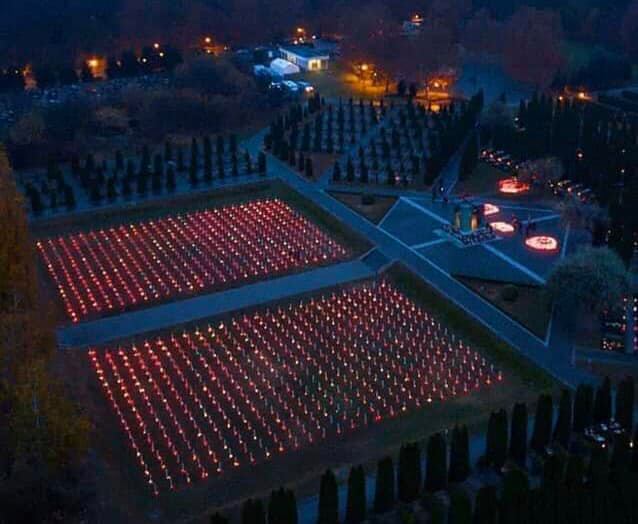
This drone shot of the Vukovar Memorial Cemetery the night before set the scene for what was to come the following day, a 6 km parade from the hospital and museum which became a symbol and focal area of the siege, to a commemoration service at the cemetery, a service attended by the Croatian President, Prime Minister and a host of other dignitaries, as well as tens of thousands of people.

My journey that day actually started in Vinkovci, the oldest continuously inhabited town in Europe, where I was staying with friends. I managed to hook up with the Dubrovnik Trombunjeri troupe, who proved to be not only excellent company, but also very insightful guides. The road we took to Vukovar had been the only access the rest of Croatia had to the city at the height of the attack.

Flags, so many flags adorned the road as we drove past.

And the local shops brought in additional products for the occasion - lanterns and wreaths.

Our first stop was the village of Bogdanovci, where the Trombunjeri stopped to pay their respects at the memorial there.
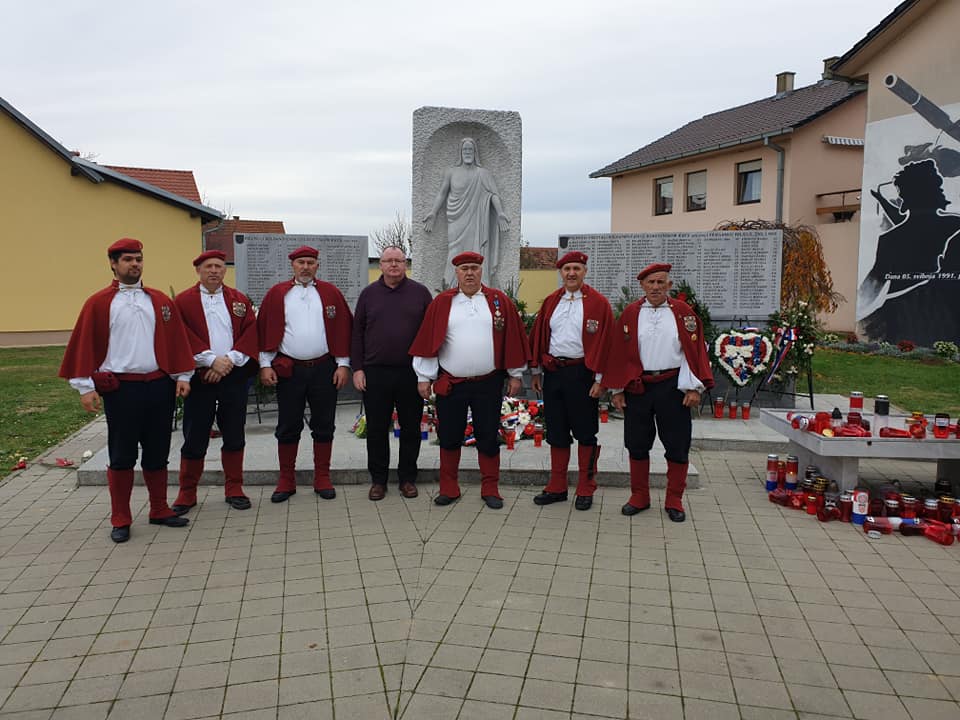
As the lifeline to Vukovar, Bogdanovci was fiercely contested.

Having fallen, the village was razed, including the church which has since been rebuilt.

And all the housing - rebuilt by the State.

Onward to Vukovar, and then the traffic slowed. I was expecting it to be due to a tractor or something similar, but it was men marching solemnly along to Vukovar.

In groups and in pairs.

The Trombunjeri went to their official programme, and I wandered towards the centre. So many flags. The atmosphere was festive, the cafes overflowing, and the beers and rakija were already flowing even though it was not yet 9 am. The joy of catching up with friends, the pain of recalling the past - this was going to be an intense day.

I toured the hospital museum a couple of years ago with members of the diaspora during the Osijek diaspora conference - it was harrowing. This is where the ceremony would begin. National television was broadcasting everything live, and the crowds had already built up. I decided to find a spot in the crowd away from the hospital to film the parade when it started.

A special mention for the police and organisers. The policing was exceptional all day, from crowd control to traffic management. With so many people descending on the town, it could easily have descended into chaos, but it was superbly organised.

The controversial 'Za Dom Spremni' slogan, part of the HOS insignia, was very evident. I mention it not to start a debate, as the issue is complex, but simply to document it. HOS were the heroic defenders of Vukovar, and so the slogan is not considered controversial there.
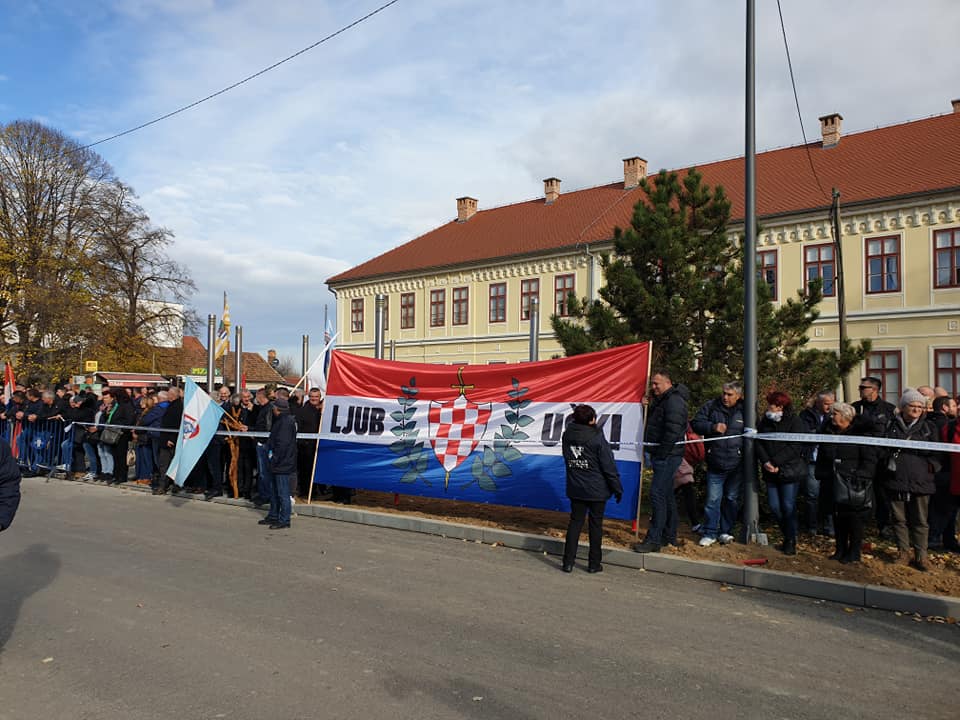
The flags were everywhere, and from every part of Croatia, and Herzegovina.

This old man with this carved wooden cross caught my attention.
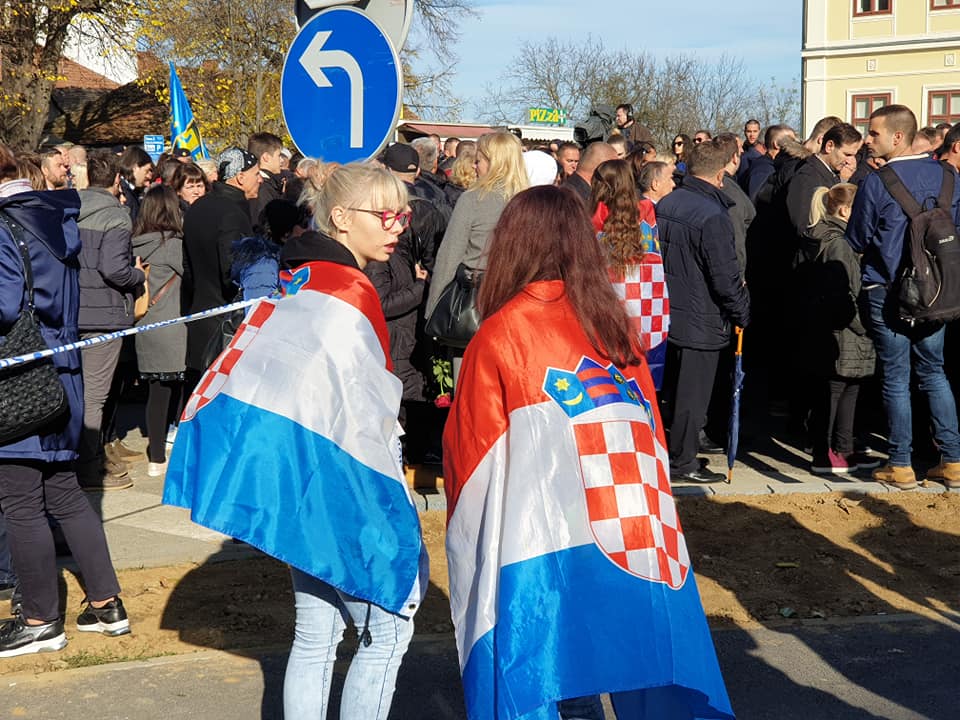
Flags everywhere.
And then things began. The Croatian National Anthem is one of the most powerful I know, arousing emotions where the British equivalent never could. God Save the Queen just doesn't compare. Put the anthem in an emotionally charged situation such as Vukovar Remembrance Day, and the effect is exponential.
And so they came. The first of thousands, including the bright colours and banners of the Sinj Alka, Dubrovnik Trombunjeri, troupes from Klis, Pozega, Karlovac and many others.
Followed by the military brigades.

And onward we walked, through the historic centre of Vukovar, past the Radio Vukovar building, where the famous reporting of Sinisa Glavasevic was being played on the loudspeaker.
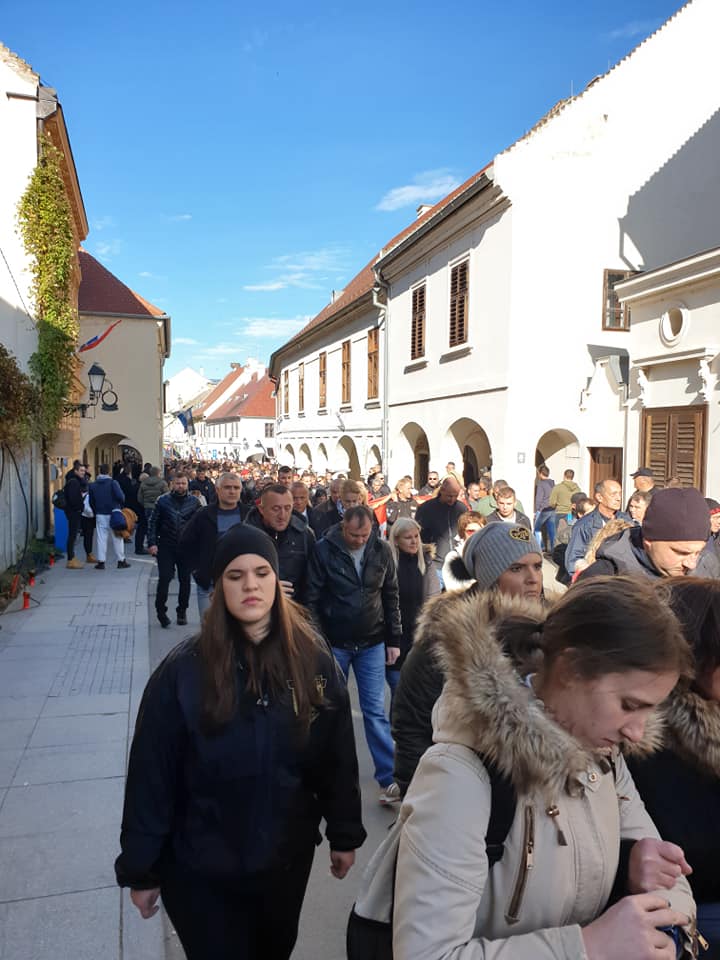
Thousands.

And then I saw - and captured - the two images which will stay with me the most from this intense day. Walking along the high street, a few people were taking photos of this family, who were watching the parade from their living room. I asked if I could take a picture, and the father motioned his assent. A powerful picture, but one which was about to get more powerful...

... as a little bundle of joy, totally oblivious to what was happening, burst into the room. The next generation of Vukovar residents - may the politicians not fail him and his generation.

Onwards past the iconic Vukovar water tower.

Thousands.

Onward, outside the city limits.
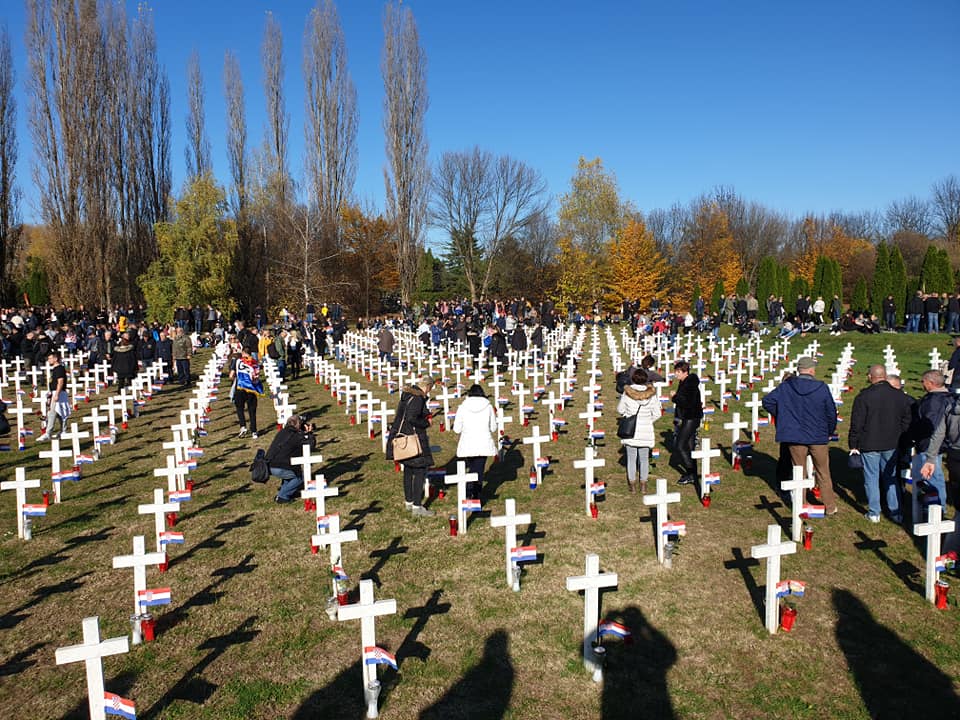
And into the final destination, the Vukovar Memorial Cemetery. Humbling.

I was late for the laying of the wreath, but here is a little of the atmosphere near the eternal flame.

The traditional troupes from all over Croatia posed for their photographs.
There was a commemorative service which was broadcast live on television. I went instead with the Trombunjeri and the others back into town by bus. The trip took us on a detour through Ovcara, scene of a large massacre after the fall of the town. From there, the Croatian army had invited anyone who wanted to come to a lunch of 'grah' (beans) and so we headed to the tents by the museum there, which also housed some incredible examples of the weaponry used during the conflict.

Improvised armoured carriers at their most basic.

The Mad Max version.
Lunch was a fascinating affair, as people of all ages and backgrounds mixed on the wooden benches in the tents. To my left, three veterans recalling how they could judge the impending impact from the differing sounds of howitzers, to my right, a conversation with a Vukovar-born member of the Ministry for Veterans Rights. It was a fascinating chat, one to be continued over coffee in Zagreb later this month.

Before leaving, the Trombunjeri had one obligation in a school. I followed them in and was struck by what I saw. This most divided of cities has a large population of both Serbs and Croats. School takes place for both communities in the same building but separate lessons, Latin script for the Croats, Cyrillic for the Serbs (this is the door for the Second Grade classroom). With so many open wounds and unserved justice, that division is completely understandable.
And yet I was thinking only of the boy and that face of abundant joy earlier in the day. How to keep that joy and move his generation forward to a better and more hopeful future?

One of the things that shocked me as a foreign parent here was the homework given to 7-year-olds. My daughter got her first nightmare at the age of seven on November 19 of that year. It took me some time to figure out what had caused such distress, but then I learned about the homework. It is an incredibly difficult and emotive subject, and not one for a foreigner. But how do we remember and honour the past and move forward with the future from homework like the above to this, below?

I don't know. I don't even know if it is possible.
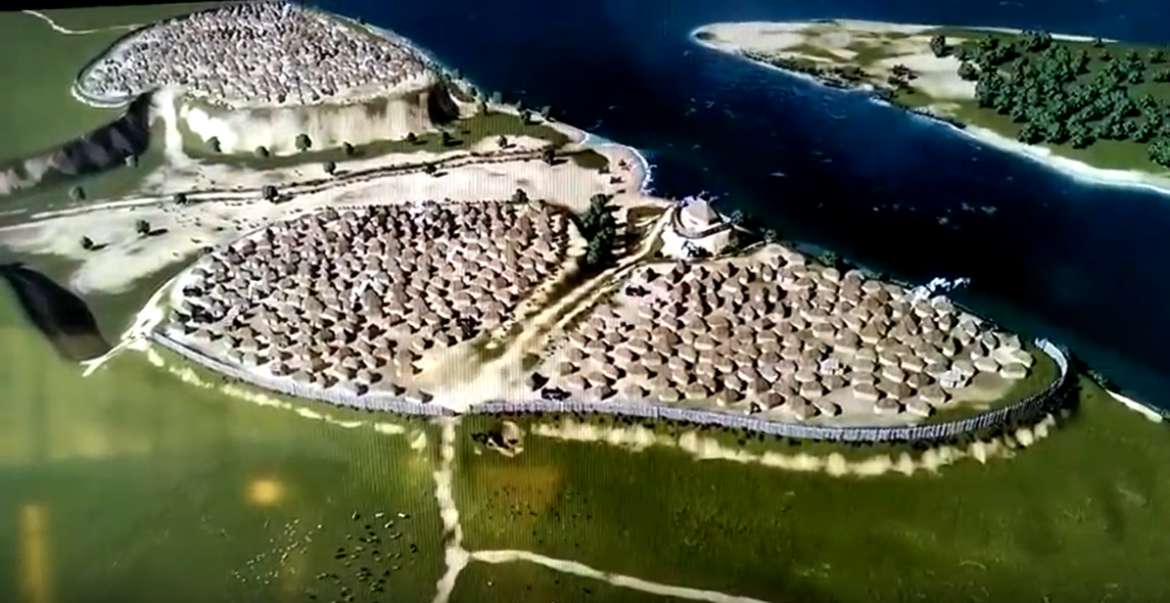
It would be easy to conclude from the media that Vukovar and the eastern region is a place of doom and gloom, but the truth is that it is absolutely fascinating, and there are so many incredible things here which can be developed. Directly across from the cemetery is one of them, one of the most sensational things in all Croatia, that very few people know about. Learn more in Vucedol Era: When Eastern Croatian Settlements Most Important in All Europe.

And for those who think that Vukovar is all ruined buildings, they are in for a big surprise, as this image of Eltz Palace from the recent Days of Croatian Tourism event shows.
The visit to Vukovar Remembrance Day was emotionally draining, but worth every effort. It also gave me one more layer of perspective on this fabulous but really complex country. My advice? Come and visit. Eastern Croatia is a wonderful place, the hospitality the warmest and most genuine in the whole country, and there is SO much to see and do. Here, for example, is how we filled an action-packed family weekend when we decided to Head On East.
And if you are looking to learn more about what Vukovar has to offer, here are 25 things to know.


